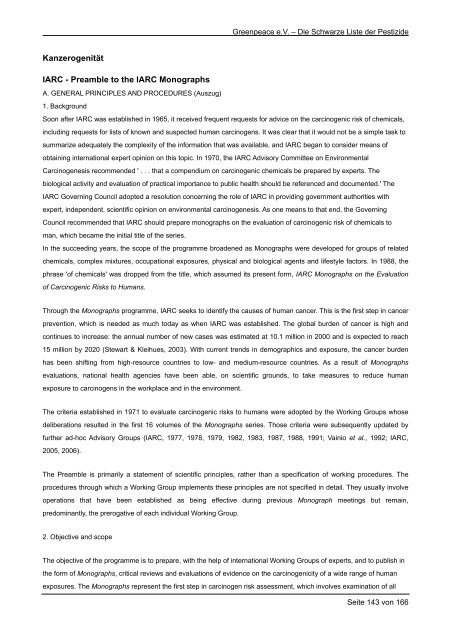Die Schwarze Liste der Pestizide - Greenpeace
Die Schwarze Liste der Pestizide - Greenpeace
Die Schwarze Liste der Pestizide - Greenpeace
Erfolgreiche ePaper selbst erstellen
Machen Sie aus Ihren PDF Publikationen ein blätterbares Flipbook mit unserer einzigartigen Google optimierten e-Paper Software.
Kanzerogenität<br />
IARC - Preamble to the IARC Monographs<br />
A. GENERAL PRINCIPLES AND PROCEDURES (Auszug)<br />
1. Background<br />
<strong>Greenpeace</strong> e.V. – <strong>Die</strong> <strong>Schwarze</strong> <strong>Liste</strong> <strong>der</strong> <strong>Pestizide</strong><br />
Soon after IARC was established in 1965, it received frequent requests for advice on the carcinogenic risk of chemicals,<br />
including requests for lists of known and suspected human carcinogens. It was clear that it would not be a simple task to<br />
summarize adequately the complexity of the information that was available, and IARC began to consi<strong>der</strong> means of<br />
obtaining international expert opinion on this topic. In 1970, the IARC Advisory Committee on Environmental<br />
Carcinogenesis recommended ' . . . that a compendium on carcinogenic chemicals be prepared by experts. The<br />
biological activity and evaluation of practical importance to public health should be referenced and documented.' The<br />
IARC Governing Council adopted a resolution concerning the role of IARC in providing government authorities with<br />
expert, independent, scientific opinion on environmental carcinogenesis. As one means to that end, the Governing<br />
Council recommended that IARC should prepare monographs on the evaluation of carcinogenic risk of chemicals to<br />
man, which became the initial title of the series.<br />
In the succeeding years, the scope of the programme broadened as Monographs were developed for groups of related<br />
chemicals, complex mixtures, occupational exposures, physical and biological agents and lifestyle factors. In 1988, the<br />
phrase 'of chemicals' was dropped from the title, which assumed its present form, IARC Monographs on the Evaluation<br />
of Carcinogenic Risks to Humans.<br />
Through the Monographs programme, IARC seeks to identify the causes of human cancer. This is the first step in cancer<br />
prevention, which is needed as much today as when IARC was established. The global burden of cancer is high and<br />
continues to increase: the annual number of new cases was estimated at 10.1 million in 2000 and is expected to reach<br />
15 million by 2020 (Stewart & Kleihues, 2003). With current trends in demographics and exposure, the cancer burden<br />
has been shifting from high-resource countries to low- and medium-resource countries. As a result of Monographs<br />
evaluations, national health agencies have been able, on scientific grounds, to take measures to reduce human<br />
exposure to carcinogens in the workplace and in the environment.<br />
The criteria established in 1971 to evaluate carcinogenic risks to humans were adopted by the Working Groups whose<br />
deliberations resulted in the first 16 volumes of the Monographs series. Those criteria were subsequently updated by<br />
further ad-hoc Advisory Groups (IARC, 1977, 1978, 1979, 1982, 1983, 1987, 1988, 1991; Vainio et al., 1992; IARC,<br />
2005, 2006).<br />
The Preamble is primarily a statement of scientific principles, rather than a specification of working procedures. The<br />
procedures through which a Working Group implements these principles are not specified in detail. They usually involve<br />
operations that have been established as being effective during previous Monograph meetings but remain,<br />
predominantly, the prerogative of each individual Working Group.<br />
2. Objective and scope<br />
The objective of the programme is to prepare, with the help of international Working Groups of experts, and to publish in<br />
the form of Monographs, critical reviews and evaluations of evidence on the carcinogenicity of a wide range of human<br />
exposures. The Monographs represent the first step in carcinogen risk assessment, which involves examination of all<br />
Seite 143 von 166

















